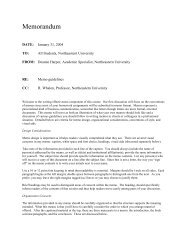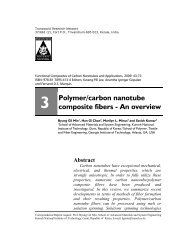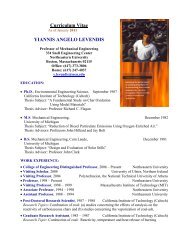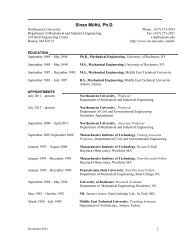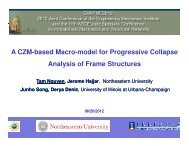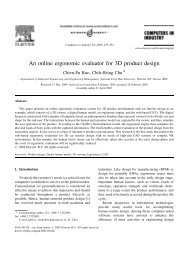You also want an ePaper? Increase the reach of your titles
YUMPU automatically turns print PDFs into web optimized ePapers that Google loves.
204 L. Pallarés, J.F. <strong>Hajjar</strong> / Journal of Constructional Steel Research 66 (2010) 198–212<br />
Fig. 2. Assessment of anchor strength using the minimum of steel <strong>and</strong> concrete failure formulas in [2] Appendix D <strong>and</strong> [6].<br />
α is equal to 0.55, given by Ravindra <strong>and</strong> Galambos [51];<br />
β is the reliability index; <strong>and</strong><br />
VR =<br />
�<br />
V 2<br />
F<br />
+ V 2<br />
P<br />
+ V 2<br />
M , where VF is the coefficient of varia-<br />
tion on fabrication <strong>and</strong> is taken as VF = 0.05 as recommended<br />
by Ravindra <strong>and</strong> Galambos [51], reflecting the strong control characteristics<br />
of stud manufacturing; VP is the coefficient of variation<br />
of Rm<br />
Rn ; VM is the coefficient of the variation of the materials <strong>and</strong> is<br />
taken as VM = 0.09 based on test data from [52–54].<br />
Ravindra <strong>and</strong> Galambos [51] recommend a reliability index β<br />
of 3 for members <strong>and</strong> 4.5 for connections. In this work, a reliability<br />
index of 4 has been targeted to compute the resistance factors.<br />
Resistance factors for steel strength prediction using only tests<br />
that failed in the steel are computed for values of the Cv coefficient<br />
equal to 1.00, 0.75 <strong>and</strong> 0.65 (Table 6). Values of the resistance factor<br />
for a β value of both 3 <strong>and</strong> 4 are presented. Eq. (2) presents a sample<br />
calculation for Cv = 1.00 <strong>and</strong> β = 4.<br />
φv = Rm<br />
e<br />
Rn<br />
(−0.55βVR) (−0.55·4.0·0.160)<br />
= 0.933e = 0.65. (2)<br />
With Cv = 0.65 the resistance factor computed by Eq. (2) is larger<br />
than 1.0, so it should be taken as 1.0.<br />
Table 6<br />
Resistance factors computed for CvAsFy for Cv = 1, Cv = 0.75 <strong>and</strong> Cv = 0.65 for<br />
steel strength based on steel failure in tests.<br />
202 tests Cv µ σ C.O.V. φ<br />
β = 3 β = 4<br />
S1 1.00 0.933 a<br />
S2 0.75 1.224 a<br />
S3 0.65 1.436 a<br />
0.150 0.161 0.68 0.61<br />
0.200 0.161 0.89 0.80<br />
0.231 0.161 – 0.94<br />
a With measured values reported by authors or nominal values if the measured<br />
steel strength was not reported.<br />
6. Formulas for concrete failure<br />
The concrete failure formulas of ACI 318-08 <strong>and</strong> PCI 6th Edition<br />
are geared for general conditions for preventing failure of headed<br />
steel anchors, especially cases where free edges may be close to<br />
the stud. Such free edges rarely occur in composite construction.<br />
Thus, several alternative formulas were developed in this work<br />
to compute the concrete strength surrounding headed studs for<br />
conditions commensurate with composite construction. These<br />
formulas are compared with the AISC <strong>and</strong> EC-4 formulas in Table 7.<br />
It can be seen that the mean value of the test-to-predicted ratios for<br />
the AISC formula in particular is quite low, coupled with a relatively<br />
large coefficient of variation. Both the optimized formula <strong>and</strong>



